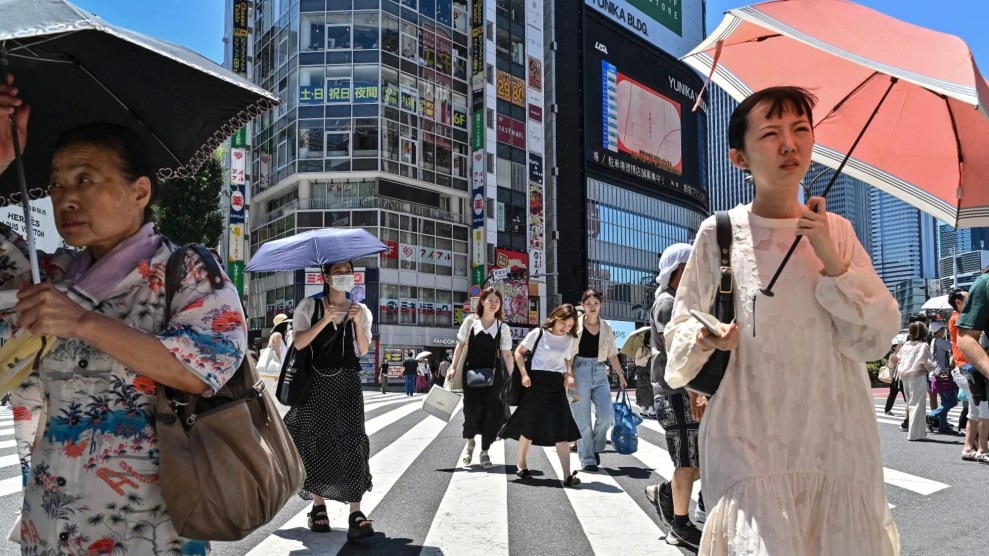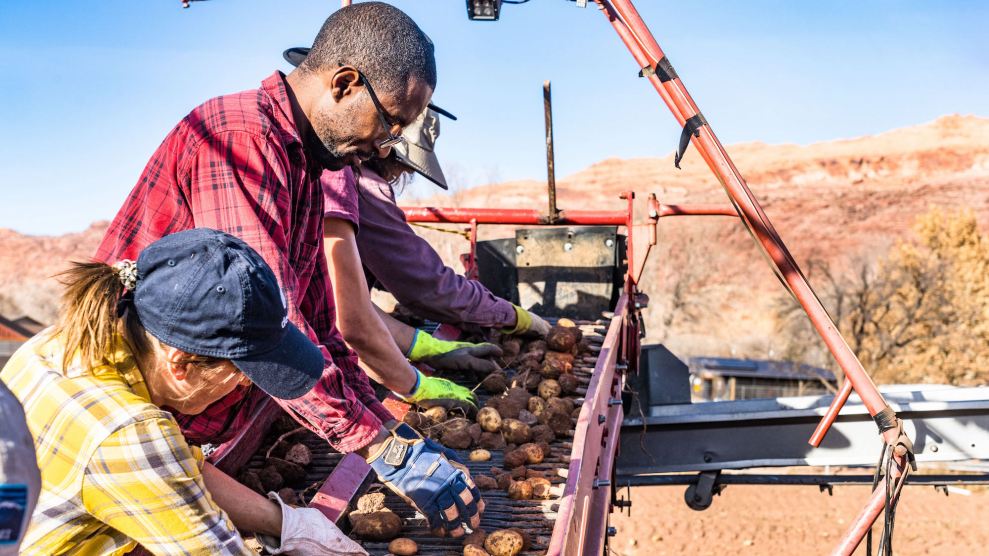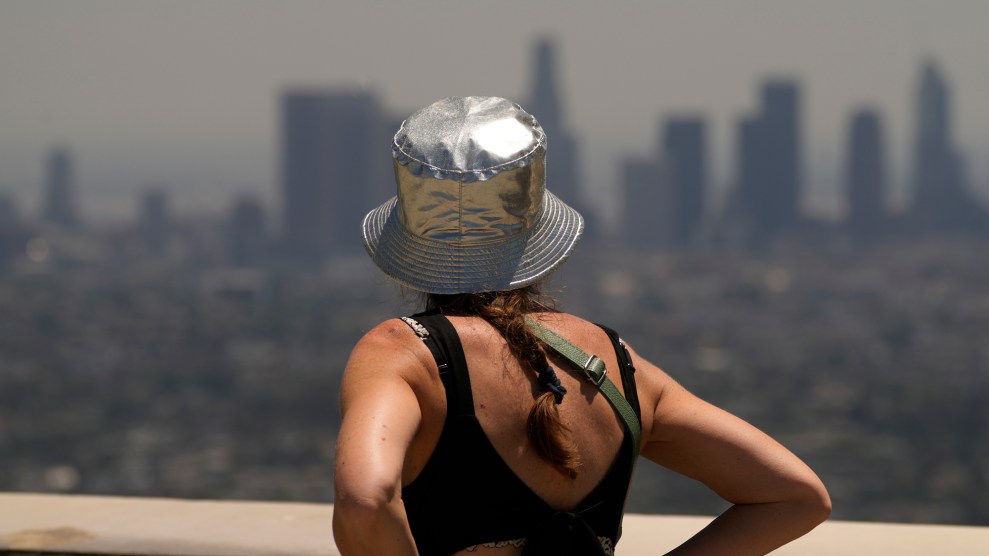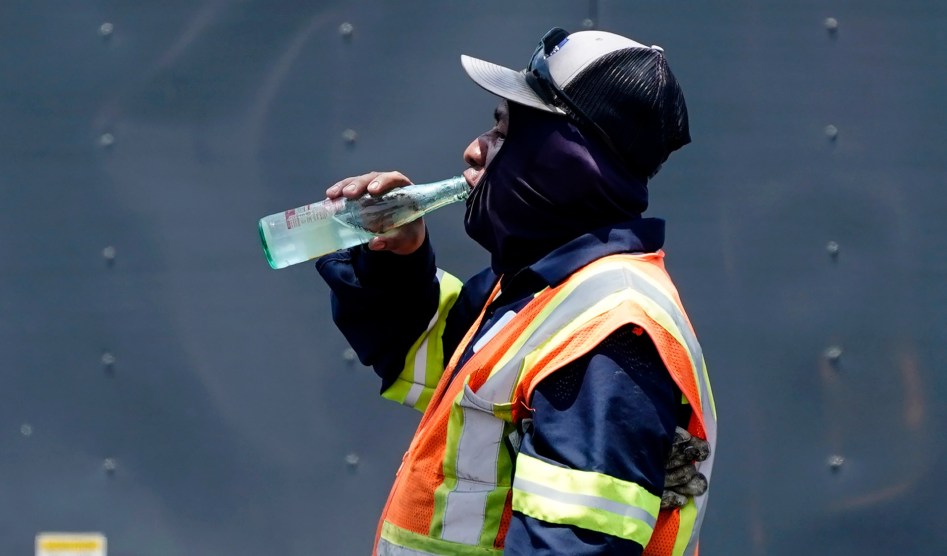
Umbrellas are a common way for city dwellers to stay a bit cooler.Richard A. Brooks/Getty via Grist
This story was originally published by Grist and is reproduced here as part of the Climate Desk collaboration.
People buy insurance to protect against unlikely but devastating events, big catastrophes that drive households and businesses to financial ruin and bankruptcy. That makes insurance most people’s first line of defense against climate disasters, which now destroy tens of billions of dollars of property in the United States every year. It makes good sense to pay a couple hundred dollars a month in premiums so you don’t go broke if a flood, hurricane, or wildfire destroys your house.
Heat has long been the exception to this rule among climate disasters. Because heat waves don’t tend to destroy homes and businesses, it’s not practical for most people to buy insurance against high temperatures, and thus there’s never been such a thing as widespread commercial “heat insurance.” Big farming operations may take out insurance to protect against a hot spring that kills crops, and retail companies may buy a policy to hedge against a decline in foot traffic on scorching days, but ordinary people historically don’t want or need financial protection against heat.
Over the past few years, as scorching heat waves have become more common with worsening climate change, that has begun to change. A new suite of unconventional heat insurance products has emerged in a range of countries around the world: Japanese insurers began to sell single-day heatstroke insurance; a charitable foundation launched a program to insure Indian workers against lost wages; and an experimental new policy emerged to protect British farmers against heat stress in cattle.
Some of these new products have drawn lots of media attention in the United States, but experts believe it’s unlikely that heat insurance will ever become a big commercial industry like fire and hurricane insurance are today. Instead, they say, heat insurance makes more sense as a financial tool to help protect people in developing countries against climate change—but only if it’s coupled with government policies that reduce the risks of heat for good.
The heat insurance trend broke into the mainstream last year when two major Japanese insurance companies rolled out novel heatstroke insurance products. Japan was enduring a sweltering summer, and the companies were aiming to capitalize on concern about heat exposure by offering short-term health insurance plans that exclusively covered heatstroke. The plans led to a flurry of media coverage in financial publications like Bloomberg, Fortune, and the Financial Times.
Even in a national insurance market known for innovation, the Sumitomo Life heatstroke program stands out as unusual. Using a mobile app, a customer pays the equivalent of about 70 cents for a one-day insurance policy that kicks in at 10 a.m. If the buyer suffers heatstroke over the course of the day and ends up in the hospital, the policy covers the costs of an intravenous drip and most other medical treatment. (Japan has a universal health care system funded by tax revenue and premiums, but patients still pay a copay for most health services and treatments.) A customer can also pay about $1.57 for a plan that lasts an entire month. The program offered by the other company, Sompo, works more or less the same way.
More than 80,000 people have enrolled in Sumimoto Life’s program since it launched last summer, said Junichiro Kaneda, a spokesperson for the insurance company. During the hottest stretch of last summer, several thousand people purchased the coverage per day.
“Due to the abnormal weather conditions in the summer, the risk of heatstroke has been reported daily in the media, leading to an increase in people’s potential anxiety,” said Kaneda in response to questions from Grist. “Therefore, it is expected that the market will expand.”
Another heat insurance program in the north of India drew a similar rush of media attention this spring. The program, led by the Adrienne Arsht-Rockefeller Foundation, provides “heat income micro-insurance” to thousands of women who work outdoors in the state of Gujarat, aiming to protect them from losing wages on the days when it’s too hot to work.
Arsht-Rockefeller, which has also endowed “chief heat officer” positions in cities around the world, partnered with the insurance startup Blue Marble to enroll 21,000 women in the program. The women are members of the Self-Employed Women’s Association, a trade union that represents more than 2.5 million female day laborers in northern India who work in a wide variety of jobs, from salt harvesting to street-food vending.
Former Secretary of State Hillary Clinton visited India in February to see how salt harvesters were dealing with high temperatures and later announced that she would serve as Arsht-Rock’s “global ambassador for heat, health, and gender.”
In contrast to the traditional insurance model, where a customer receives a payout only after filing a claim for a specific amount of damage, the program uses what’s known as a “parametric” system, meaning it pays out when measurable conditions meet certain parameters. The women pay a $3 enrollment fee, equivalent to about a day’s wages, and if local temperatures average above 90 degrees for three straight days, they receive a digital cash transfer worth a few days’ wages, allowing them to stay home from work. (The enrollment fee doesn’t reflect the full cost of the premiums, which Arsht-Rock and an anonymous donor paid for.) The foundation also distributed gloves to protect workers from hot surfaces and electrolyte tablets to help them stay hydrated.
“The solution for heat right now, while the workers have blisters on their hands, is something immediate,” said Kathy Baughman-McLeod, the director of Arsht-Rock. “The main thing to worry about is, of course, their income, because they have to feed their kids even if they can’t work, right?”
The program went through a two-month test run earlier this year, but even though India suffered through an extended heat wave for most of the spring, the temperature never got high enough to trigger a payout. But the foundation plans to expand the program to millions more women in India over the next few years, and also plans to add an early warning system that alerts workers about heat via WhatsApp.
For the moment, though, all these programs are still niche initiatives. The Arsht-Rock adaptation initiative and the Sumitomo insurance plan reached just a few tens of thousands of people each, and other heat insurance products are even smaller. A parametric insurance program for heat-stressed cattle that launched in the United Kingdom this year is still in a trial phase. That program distributes immediate payments to dairy farmers during heat waves, accounting for the fact that cows can get sick or even die during hot spells.
Heat insurance is unlikely to become a big commercial market in the Global North anytime soon, says Jisung Park, an assistant professor at the University of Pennsylvania who studies climate risk and finance. The Sumitomo heatstroke program might sell well in Japan, a very elderly country where many people are anxious about heat, but Park says most people in the US and other developed countries likely wouldn’t feel the need to get extra coverage.
“In terms of salience, [heat] is certainly not up there as a big perceived risk,” he told Grist. For most Americans, he said, “the idea of expanding your health insurance coverage for a risk that you’re going to incur by going outside is really kind of unusual. It’s sort of like the salesman at the rental car agency trying to scare you into buying additional coverage even though you already have coverage.”
By the same token, the income insurance that Arsht-Rock designed for Indian workers likely wouldn’t appeal to workers in developed countries who have robust workplace protections, paid sick leave, or unemployment benefits. Rather, it’s meant to protect vulnerable self-employed populations who don’t have a safety net. Even though this kind of heat income micro-insurance might appeal to workers in the US who don’t have a centralized employer and who face extreme risk working outdoors on hot days—like day laborers, delivery workers, and agricultural workers—Arsht Rock is focusing for the moment on expanding it in the Global South.
Instead of spurring new types of insurance products, heat waves are more likely to place more stress on existing insurance markets in the United States and other developed countries. Most U.S. states require employers to carry worker’s compensation insurance that cover on-the-job injuries, including those related to heat. Park’s own research shows that heat waves make on-the-job injuries much more likely, which could one day place a new strain on the worker’s comp system and drive up premiums.
In the developing world, though, parametric insurance will be an essential part of adapting to climate change, said Ekhosuehi Iyahen, the secretary general of the Insurance Development Forum, a partnership between the World Bank and major insurers that aims to design new climate insurance for developing countries.
“In the developing world context, we’re dealing with markets where insurance is not readily available, accessible, affordable,” Iyahen told Grist. “There’s a huge protection gap that exists there, and that’s very different from most developed markets where insurance in most instances is built out.”
Even so, said Iyahen, the best solution might not be heat insurance as such. For outdoor workers like the women in Gujarat, the temperature outside is the most important factor in whether it’s safe to work, but heat can also cause droughts, wildfires, or crop failures. Adapting to climate change requires cushioning people in developing countries from the losses that follow big disasters, and parametric insurance can help do that. The programs allow people to insure themselves against all kinds of calamities, not just the ones that destroy property, and it also makes payouts faster and easier, removing the need to file and authenticate claims.













